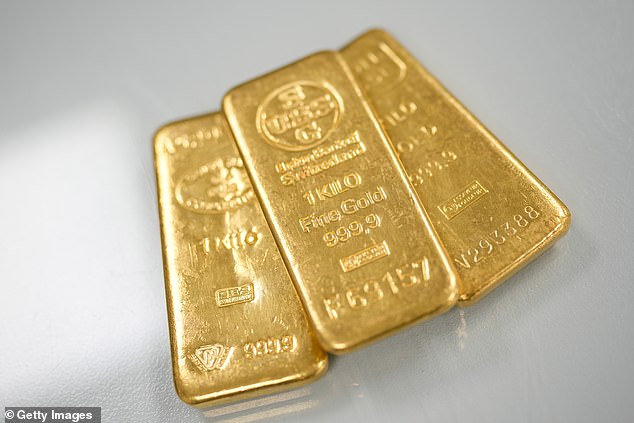- Gold prices have been on a bumper rally since the begining of last month
- Hopes of interest rate cuts by the US Federal Reserve have also boosted prices
Gold prices jumped to a record high on Monday after China’s central bank continued buying up the precious metal for its reserves.
An ounce of gold hit $2,355 in Asian trading as the People’s Bank of China bolstered its gold reserves to 72.74 million fine troy ounces in March, its 17th successive month of purchases, according to official statistics.
Gold has been on a bumper rally since the start of last month driven by the purchases of various central banks, with 64 net metric tonnes bought in January and February alone, data from the World Gold Council shows.

Price surge: Gold has been on a bumper rally since the start of last month following purchases by various central banks, with 64 net metric tonnes bought in January and February
It has also been elevated in recent weeks by impending hopes of interest rate cuts by the US Federal Reserve.
The Fed hiked its funds rate 11 consecutive times between March 2022 and July 2023 in response to rising inflation before holding it steady at 5.25 to 5.5 per cent.
As a result, the US inflation rate has slumped from double-digit levels to 3.2 per cent in February, boosting the likelihood of the central bank cutting the funds rate in the coming months.
Gold prices have historically tended to be inversely correlated with interest rates, as cutting the latter makes the former a more attractive investment relative to fixed-income assets like bonds.
Analysts from UBS Global Wealth Management predict gold exchange-traded fund holdings will rise once the Fed begins lowering rates ‘as these buyers tend to move more in sync with interest rate adjustments’.
As a result, UBS GWM is now forecasting gold’s value will rise to $2,500/oz by the end of 2024, an upgrade on previous forecasts of $2,250/oz.
‘Renewed price setbacks in the short term remain possible if US economic data delays Fed rate cuts, but so far, these setbacks have been shallower than we had expected,’ it said in a note.
Gold prices are not a function of interest rates and are driven by supply and demand dynamics, like other goods and services.
The World Gold Council said annual gold demand, including over-the-counter orders, expanded by 3 per cent to a record 4,899 tonnes in 2023.
Much of this growth was driven by households and investors in China, who increasingly bought bullion due to severe pressures within the country’s stock market and property sectors.
Prices have received a further uplift from the geopolitical tensions posed by the conflicts in Ukraine and the Middle East.
Gold is often seen as a safe haven during times of crisis, especially recessions, because it acts as a hedge against inflation and offers diversification for investors.




